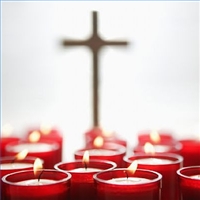The Human Need For Symbolism and Ritual
by Archbishop Lazar Puhalo
 Recently, near our monastery, a seventeen years old girl was killed in an auto accident. She had been speeding and lost control of her car. By evening, there were dozens of candles burning beneath the tree into which she had crashed. Mounds of flowers, cards and notes appeared, and someone placed a wooden cross against the tree with her name on it. A month later, candles are still being lit at the site.
Recently, near our monastery, a seventeen years old girl was killed in an auto accident. She had been speeding and lost control of her car. By evening, there were dozens of candles burning beneath the tree into which she had crashed. Mounds of flowers, cards and notes appeared, and someone placed a wooden cross against the tree with her name on it. A month later, candles are still being lit at the site.
Last week, Father Moses and I travelled to a small city in the northeastern part of our province to serve a funeral for a young Orthodox man who had drowned on a fishing trip. Of the approximately 250 people who attended the funeral, many of them classmates from the young man’s school, not more than a dozen were Orthodox. The people were either Protestant or of no religion, but most of them especially the youth, brought candles to light. The majority of them took time to come and tell us how meaningful the Orthodox funeral service had been. Not a few of them commented on the penetrating symbolism in the words and ritual of the service.
One young man commented,
“I became aware that you were not serving for John, but were serving with him. It made me realise that he has a soul that is still alive.”
At an earlier funeral which we served in another town, the warden of the United Church was present. Afterward he remarked, “I was so struck to realise that you were serving the funeral with the deceased, rather than for her.” The symbolic actions in the service had clearly penetrated the man’s understanding, even though his denomination has almost totally renounced any form of symbolism in worship.
We have seen this deep human need for symbolism so many times before and in history as well. When symbolism in worship and in life are missing, people create their own and respond to it. When the symbolism they adopt is not divinely inspired and rooted in the Sacred Tradition of Christianity, it often incorporates pagan ideas and folds into the “New Age Movement.” Such symbolism and symbolic actions so profoundly convey and establish spiritual, emotional and cultural concepts, knowledge and values that no society or culture is without them. Symbolic actions and symbolism in worship arising from the Sacred Tradition and experience of the Holy Church help maintain the doctrine and inner life of the Christian faith.
The Orthodox Church has always understood this. Without symbolic actions and symbolism in divine services, both teachings and worship become the sterile reserve of dry intellectualism. Indeed, some of our own intelligentsia advocate that we abandon the idea of symbolism and symbolic understandings in the Divine Liturgy, Vespers and Matins, and render them as concrete and sterile theological intellectualisms, accessible only to scholastic, rationalistic minds. In this way, they would become external and lack the power to penetrate the soul the way symbolic understandings do.
Human language is symbolic. It conveys information, concepts, ideas and values in a symbolic manner. Language developed on the matrix of vision. This is clear both physiologically and theoretically. Vision transfers patterns and reflections of light into symbolic images in the brain. Words are symbols whose meanings are established by cultural, religious or legal norms. Defined symbolism can be grasped and understood even by simple, uneducated people for whom concrete intellectualised and philosophically elegant refinements are completely inaccessible. So too are the sophisticated abstractions so often expressed by theologians.
The Liturgy, we know, is eschatological, it carries us into the eternal wedding banquet of the Heavenly Bridegroom.
Fine, but what has this to say about the daily struggle of the ordinary Orthodox Christian worshipper?
What visible symbolism can the overworked, stressed and harassed daily commuter, concerned about his or her mortgage, the needs and education of their children, coping with taxes, maintaining a home and automobile, and now trying to pay for gasoline, find in the Liturgical cycle, that is easily accessible to them and elevating to their souls in a straightforward way that they can comprehend? Is the Orthodox faith and worship ultimately only truly accessible to the intellectual and his remote, abstract understandings and interpretations?
This is why there are clearly symbolic actions in the divine services, and symbolism in both iconography and the structure of the Orthodox temple and in particular, in the altar. Our philosophical rationalists may claim that such symbolism is not needed and that interpretations of the Liturgy expressing the symbolic aspects of it are “accretions,” but this only proves the point that meaning is conveyed symbolically. They may be able to offer a highly refined and elegant philosophical concept of the Liturgy, but their hearts might never be penetrated with its actual meaning which underpins the daily spiritual struggle of the sincerely pious faithful.
